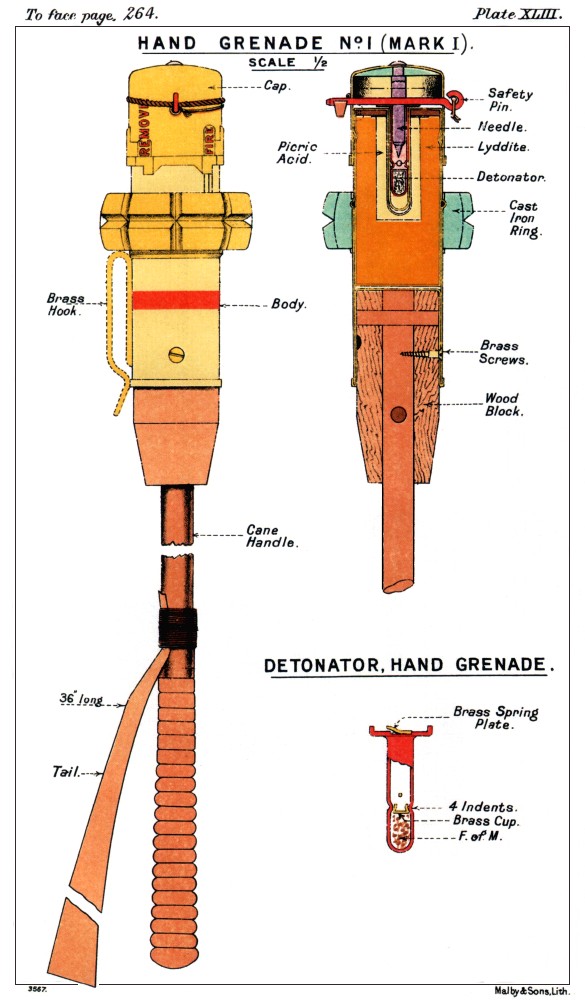No 1 Grenade on:
[Wikipedia]
[Google]
[Amazon]
The Grenade, Hand, No. 1 was the first British hand grenade used in  The grenade proper is a container of explosive material with an iron fragmentation band. The fuse was of the impact sort, detonating when the top of the grenade hit the ground. A long cane handle (approximately 16 inches or 40 cm) allowed the user to throw the grenade further than the blast of the explosion.
To ensure that the grenade hit the ground nose first, a cloth streamer was attached to the end of the handle. When thrown, this unfurled and acted as a tail to stabilize flight. The grenade came with a metal loop so it could hang from a belt.
The grenade proper is a container of explosive material with an iron fragmentation band. The fuse was of the impact sort, detonating when the top of the grenade hit the ground. A long cane handle (approximately 16 inches or 40 cm) allowed the user to throw the grenade further than the blast of the explosion.
To ensure that the grenade hit the ground nose first, a cloth streamer was attached to the end of the handle. When thrown, this unfurled and acted as a tail to stabilize flight. The grenade came with a metal loop so it could hang from a belt.
World War I
World War I (28 July 1914 11 November 1918), often abbreviated as WWI, was one of the deadliest global conflicts in history. Belligerents included much of Europe, the Russian Empire, the United States, and the Ottoman Empire, with fightin ...
. It was designed in the Royal Laboratory, based on reports and samples of Japanese hand grenades during the Russo-Japanese War
The Russo-Japanese War ( ja, 日露戦争, Nichiro sensō, Japanese-Russian War; russian: Ру́сско-япóнская войнá, Rússko-yapónskaya voyná) was fought between the Empire of Japan and the Russian Empire during 1904 and 1 ...
provided by General Sir Aylmer Haldane, who was a British observer of that war.
 The grenade proper is a container of explosive material with an iron fragmentation band. The fuse was of the impact sort, detonating when the top of the grenade hit the ground. A long cane handle (approximately 16 inches or 40 cm) allowed the user to throw the grenade further than the blast of the explosion.
To ensure that the grenade hit the ground nose first, a cloth streamer was attached to the end of the handle. When thrown, this unfurled and acted as a tail to stabilize flight. The grenade came with a metal loop so it could hang from a belt.
The grenade proper is a container of explosive material with an iron fragmentation band. The fuse was of the impact sort, detonating when the top of the grenade hit the ground. A long cane handle (approximately 16 inches or 40 cm) allowed the user to throw the grenade further than the blast of the explosion.
To ensure that the grenade hit the ground nose first, a cloth streamer was attached to the end of the handle. When thrown, this unfurled and acted as a tail to stabilize flight. The grenade came with a metal loop so it could hang from a belt.
In the trenches
When the battlefield became confined to thetrenches
A trench is a type of excavation or in the ground that is generally deeper than it is wide (as opposed to a wider gully, or ditch), and narrow compared with its length (as opposed to a simple hole or pit).
In geology, trenches result from erosi ...
, the long handle became a liability, causing several accidents. Reaching back for the throw, the fuse could strike the trench side. The No. 3, a variant of the No. 1, had a shorter handle for easier use in trenches.
Even with these adjustments, the No. 1 and its variants did poorly in battle. According to German prisoners captured at Ypres
Ypres ( , ; nl, Ieper ; vls, Yper; german: Ypern ) is a Belgian city and municipality in the province of West Flanders. Though
the Dutch name is the official one, the city's French name is most commonly used in English. The municipality c ...
in January 1916, the No. 1 could be deflected by wooden boards. In some cases, the deflected grenade could be thrown back.
Manufacturing the No. 1 was difficult, as it required a special detonator that could only be produced by the ordnance factories. Because of this, the British Expeditionary Force got far fewer No. 1s than were ordered. A version that used a more common detonator, the No. 18, was designed, but by then battlefield experience had shown that the No. 1's design was ineffective.
The difficulty of operating it in trenches plus the special detonator caused Britain to create several stopgap grenades, such as the jam tin grenade
The double cylinder, Nos. 8 and No. 9 hand grenades, also known as the "jam tins", are a type of improvised explosive device used by the British and Commonwealth forces, notably the Australian and New Zealand Army Corps (ANZAC) in World War I. The ...
, until the Mills bomb
"Mills bomb" is the popular name for a series of British hand grenades which were designed by William Mills. They were the first modern fragmentation grenades used by the British Army and saw widespread use in the First and Second World Wa ...
was adopted.Saunders, ''Weapons of the Trench War'', p.7.
References
External links
{{WWI British Empire small arms World War I grenades of the United Kingdom Fragmentation grenades Hand grenades of the United Kingdom